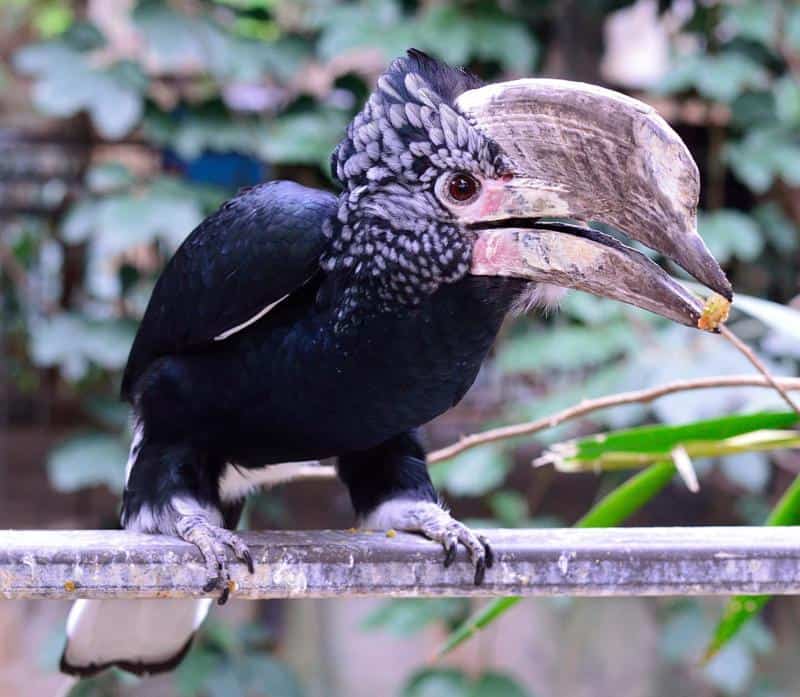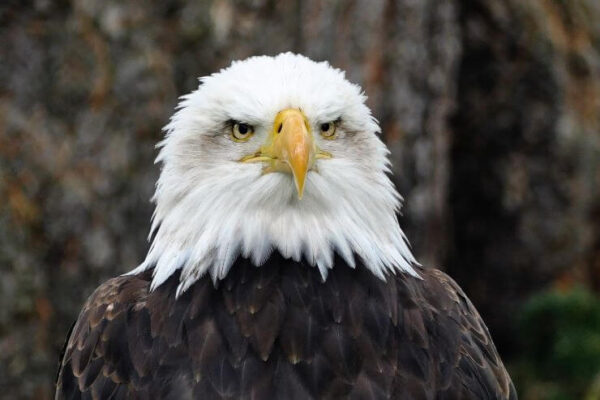Birds often have beaks, which are mouths without teeth that are coated with keratin.
Each species of bird has developed its beak to serve a specific purpose for both itself and its surroundings. These purposes include eating (for both the parent and young bird), nest building, controlling body temperature, grooming, mating, and defense.
The form and functions of beaks may be classified into numerous groups, such as hooked, cone-shaped, short curved, straight thin, long thin needle-like, crossbill, flat white, spatulate, huge, long, strong, and multifunctional beaks.
Get ready to be amazed—this post is about the largest and most amazing beaks.
Ten Large-Beaked Birds
Sulawesi Wrinkled Hornbill

The Sulawesi Wrinkled Hornbill, or Knobbed Hornbill (Rhyticeros cassidix), is a blackbird with white tail feathers, a bare dark-blue neck, blue skin around its eyes, and a large yellow beak with a knob on top.
The distinctive feature that sets the Knobbed Hornbill apart is the red “hat” with orange ridges perched atop its large yellow beak.
The main foods of the Knobbed Hornbill, which inhabits the canopy of Indonesian forests, are fruits (figs), insects, the eggs of other birds, and even young birds.
June to July, when the wet season ends, is breeding season.
The female Knobbed Hornbill locks herself inside a big tree with food, dung, and feathers, leaving just one small opening that the male uses to feed it and the younglings. The male seeks this hole.
African Sacred Ibis

The African Sacred Ibis, or Theskiornis aethiopicus, is a white wading bird with black legs, a long, curved beak, a bald head and neck, and white wings with a black stripe at the tips.
When foraging, the African Sacred Ibis uses its long, narrow, downward-curving beak to assist it dig through the mud and sand of shallow waterways.
Native to Sub-Saharan Africa, southeast Iraq, and Yemen, the African Sacred Ibis was brought to Europe and subsequently expanded to Florida, Taiwan, and the United Arab Emirates. Its preferred habitat is marshes and shorelines.
The African Sacred Ibis is a carnivorous bird that consumes fish, frogs, reptiles, insects, and their larvae.[2]
The African Sacred Ibis breeds in colonies, generally in baobab trees, and its breeding season runs from March to August in Africa and April to May in Iraq.
One to five eggs are laid by the female each season in a stick nest, which is incubated by both parents. After the eggs hatch, only one parent stays in the nest for the first week.
Great White Pelican

Large and white, the Great White Pelican (Pelecanus onocrotalus) has a pale-yellow jugular pouch, pink legs, and a massive pink-yellow beak.
When the Great White Pelican puts its lower beak below, it “spreads,” forming a pouch that holds fish and water. When the bird raises its head, the “pocket” constricts, removing the water and retaining the fish.
The Great White Pelican uses this kind of fishing approach and requires warm freshwaters from lakes, marshes, deltas, and swamps in Europe, as well as lowlands, freshwater, or alkaline lakes in Africa.
The Great White Pelican eats on (large) fish, weighing 500–600 g, as you have probably figured by now. However, it also takes advantage of opportunities to hunt the eggs and younglings of other birds.
In Africa, breeding season lasts all year round, while in Europe’s moderate environment, it often begins in April or May.
The Great White Pelican breeds in colonies, and although some populations build stick nests in trees, the majority of the birds prefer the scrapes on the ground that are enhanced by grass, sticks, feathers, and other materials.
The younglings are raised by both parents, and the female produces one to four eggs on average.
Silvery-Cheeked Hornbill

This enormous hornbill, known as the Silvery-Cheeked Hornbill (Bycanistes Brevis), has a silver-grey head, a body that is sparkling black, white plumage on the lower back, thighs, and tip of the inner tail feathers, grey-blueish legs, and a large pale beak with a bonnet on top.
The Silvery-Cheeked Hornbill’s beak is designed to accommodate its varied diet, which consists of fruits, insects, centipedes, tiny reptiles, and small rodents.
Silver-Cheeked The African forest canopy, where hornbills reside, provides them with the required food source.
The Silvery-Cheeked Hornbill breeds from September to October. The female builds nests in trees and deposits one to three eggs, which are then incubated for forty days.
Toco Toucans

With its massive yellow-orange beak measuring between 15.8 and 23 centimeters, white neck, chest, upper tail covers, red under-tail covers, and black body plumage, the Toco Toucan (Ramphastos toco) is the largest and most well-known toucan bird.
The tongue is very flat and almost the same length as the beak, despite the beak’s appearance of weight and size. This makes the beak simple for the bird to “maneuver.”
In addition to being omnivorous, Toco Toucans also eat fruits, insects, reptiles, smaller birds, and eggs. Their large beak and flat tongue facilitate this process.
From Argentina, Bolivia, Brazil, French Guiana, Guyana, Uruguay, Paraguay, Peru, and Suriname, to semi-open areas like savanna, forests, plantations, and forest edges, Toco Toucan may be found.
The female toco toucan deposits two to four eggs in a nest high in a tree, which the parents dig to make larger. They have also been seen to nest in holes in earthbanks or in terrestrial termite nests.
Fun Fact: The Toco Toucan is regarded as a reborn devil in its home area.[3]
Wood Stork

The enormous black-and-white Wood Stork (Mycteria americana) has a huge, dark, brown beak and long, wrinkled, hairless head and neck.
The Wood Stork has a unique and effective way of using its beak to catch fish. It waits for fish to pass by by sticking its open bill into the water. When it senses a fish, it quickly closes its beak—up to 25 milliseconds—to capture the meal. [4]
Although the Wood Stork does eat fish, it also eats insects during the dry season and crabs, frogs, and insects during the rainy season.
It lives in lowlands, flooded marshes, depthless ponds, and wetlands with trees in South America, North America (so far as Florida), and tropical and subtropical Americas (including the Caribbean).
The male wood stork builds the nest, and the female lays three to five eggs that are incubated by both sexes. Wood stork colonies may have up to 25 nests in a single tree.
Grey Shoebill

The most distinguishing feature of the Grey Shoebill (Balaeniceps rex), a tall bird that resembles a grey stork and has long legs and feet, is its straw-colored beak with bulging greyish patches.
The Grey Shoebill’s beak, which may have a larger circumference than a pelican’s, is the third longest bill in the world, measuring between 18.8 and 24 cm.
The Grey Shoebill inhabits marshes and wetlands in eastern Congo, Rwanda, Uganda, western Tanzania, southern Sudan, northern Zambia, and eastern Congo.
While its primary diet consists of fish (marbled lungfish, Senegal bichir, tilapia, catfish, and Clarias), the Grey Shoebill is also open to consuming a number of other species, including frogs, water snakes, Nile monitors, and even young crocodiles.[5]
The Grey Shoebill is a solitary bird that constructs less than three nests per square kilometer, protecting a perimeter of 2-4 square kilometers around it, in contrast to its cousins, the stork.
Together, the pair constructs a 3-meter platform out of water plants, upon which they construct a 1-1.7-meter nest, on which the female deposits one to three eggs.
Both parents care for the younglings and incubate the eggs while partly submerging the platform underwater to enable the nest to float.
White-necked raven

The white-necked raven, or Corvus albicollis, is a tiny, black raven with a white mark on its neck and a prominent beak.
Its beak is “deep,” with a white tip, and it is curved almost as tightly as the thick-billed raven’s, but its tail is shorter than the common raven’s.
White-necked The rocky, open regions of hills and mountains, which are often located in tiny towns or villages in eastern and southern Africa, are what ravens love.
The White-necked Raven mostly eats insects and tiny reptiles from the ground as well as grains and peanuts from trees, but it will not give up on human food or even pick up road dead.
White-necked On the margins of cliffs (rarely in trees), ravens construct a bowl-shaped nest that is lined with grass, hair, and wool and is constructed out of sticks and twigs. Inside, the female lays three to five eggs.
The younglings leave the nest and form flocks until they are fully grown and may establish territories and form couples.
Verdant wood Hoopoe

Verdant wood Hoopoe may be identified by its bright red, slender, downcurved beak, as well as the white markings on its wings and tail tips.
The Greenwood The Hoopoe is an insectivorous bird that feeds on wood trunk bark, termite mounds, and the ground.
The Green-wood Hoopoe inhabits savanna, woodlands, riverine forests, and African suburban gardens.
The Green-wood Hoopoe has just one breeding couple and lives in “families” of up to twelve birds.
The female Green-wood Hoopoe lays two to four eggs in the nest, which is nothing more than a naturally occurring tree hollow, and incubates them for eighteen days.
Because other birds continue to feed the mother bird (and subsequently the younglings) long after they leave the nest, the Green-wood Hoopoe is considered a cooperative breeder.
Cinereous vulture

The biggest and heaviest raptor bird is the cinereous vulture (Aegypius monachus), sometimes called the “black vulture” or “monk vulture.” Its dimensions range from 98 to 120 meters in length, and it can reach heights of 2.5 to 3.1 meters when its wings are spread wide.
The adult Cinereous Vulture has dark-brown plumage with the exception of its gray down-covered head.
The bird has a blue-grey beak that is so large that it stands out among the other beaks in its family, Accipitridae, and seems even larger when compared to the average size of this species’ head. Its legs are also blue-grey.
The Cinereous Vulture hunts for dry open spaces or pastures in woods as far away from human disturbances as possible, preferring the peace and quiet that the mountains provide.
French, Portuguese, Spanish, Greece, Turkey, the Central Middle East, east of Afghanistan, northern India, and central Asia are home to the cinereous vulture, a Eurasian species that breeds in Korea, Mongolia, and north Manchuria.
The cinereous vulture is a scavenger that feeds on the carcasses of dead animals. It favors medium-sized to big mammals, including sheep, foxes, wild and domestic yaks, gazelles, kiangs, and marmots.
The mating season runs from February to October, and the ritual comprises couples dancing while in flight (but dances between younglings and pairs are not precluded).
The majority of Cinereous Vultures prefer to build their nests on the branches of cliff trees, such as juniper, oak, almond, or pine trees, as well as wild pears, while certain birds have no trouble doing so.
The nest is constructed by both couples out of sticks and twigs, and as they utilize it and “upgrade” it with animal pelts and skins over time, it becomes larger.
The female deposits one egg (two in rare circumstances), and the offspring are raised by both parents.
Were you aware?
Despite being the “cleaning crew” of the environment due to their diet, the Cinereous Vulture population has declined over the last 200 years due to poisoning, habitat damage, and a decrease in food sources. It has already gone extinct in a few European nations.


![38 Birds that Lay Speckled Eggs [Detailed Guide]](https://birdsology.com/wp-content/uploads/2023/11/8341a329b95e3bac01e26570049ce1eb-600x400.jpg)


